"I don't know if our homeland or the whole world saw something similar after the Grunwald battle," wrote one of the participants of the Battle of Beresteczek.
Beresteczko remains in the shadow of Grunwald, although both historians and writers have done their best to bring it to light. Perhaps we are forgetting about this clash, because it happened in the course of a kind of civil war. The inhabitants of the Republic of Poland stood up against the Polish army - the Cossacks headed by Ataman Bohdan Chmielnicki. However, the stakes of the Battle of Beresteczko was much greater than just the attempt to drown another rebellion in blood.
Almost like a crusade
On April 10, 1651, King Jan Kazimierz left Warsaw to face the combined forces of Cossacks and Tatars at the head of the army. The Pontifical Nuncio Giovanni de Tores gave him a papal blessing, a blessed sword, a helmet and a copy of the painting of Saint Mary of Faenza. Jan Kazimierz could read in a letter from the Holy Father that he is a "defender of the Catholic faith".
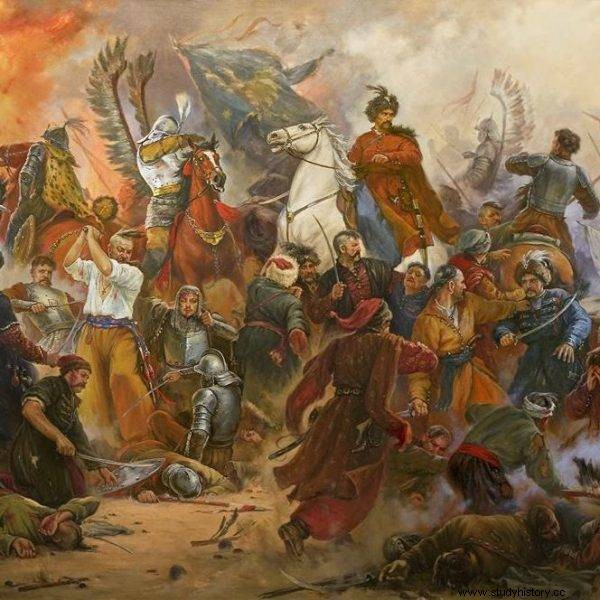
The illustration shows a fragment of Artur Orlionow's painting "The Battle of Beresteczek".
However, it was not about the Catholic faith in the expedition, but about the fate of the Republic of Poland. Admittedly, they started to face the Cossacks and Tatars, but other enemies were already waiting in the starting blocks. The defeat of the Poles would be a signal for them to attack. The Turkish sultan assured Khmelnytsky that he would support him with 100,000 soldiers. The Transylvanian prince Jerzy Rakoczy, corresponding to the rebellious hetman, was slowly getting ready to go to Krakow. Moscow was willing to accept the Cossacks "under the tsar's high hand". The Tatar legation was headed to Sweden, offering an alliance…
Jan Kazimierz from Warsaw went to Sokal, where the Polish army was concentrated. In total, 70-80 thousand soldiers gathered there (30-40 thousand mass movement, 28-30 thousand mercenary, ie professional soldiers, several thousand from private magnates' armies).
Read also:Jeremi Wiśniowiecki - hammer on the Cossacks. Black legend of prince Wiśniowiecki
"... tavern words from the king's lips and lamenting from their mother ..."
On June 15, 1651, the Polish army moved from Sokal towards Beresteczka, where it was planned to wait for the arrival of the Cossacks and Tatars. After five days of walking, on June 19, a camp was set up between Beresteczek and the village of Strumielec (Strzemilcze). And this time they stood with their backs to the river, as Polish commanders almost always did.
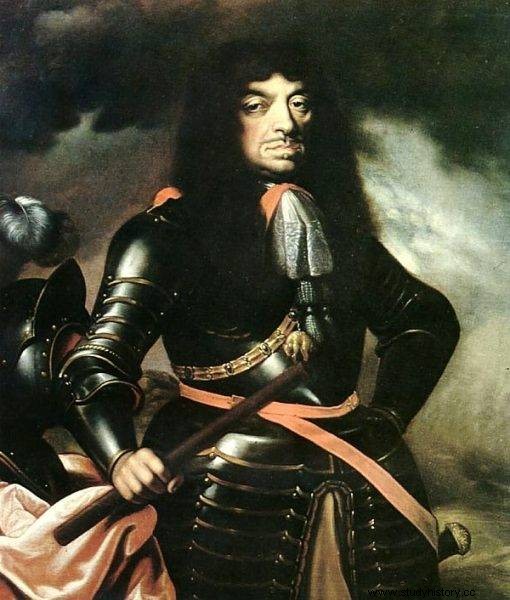
King Jan Kazimierz himself stood at the head of the army that set out to fight the Cossacks and Tatars.
The big problem was the lack of some news about the actions of the Cossacks and Tatars. Rumors reached Poles that Chmielnicki was withdrawing to the east. They were given faith, so on June 26, the order was given to break the camp. It was hoped that she would be able to get the queen before she reunites with the Tatars.
The next day, the first cars moved towards Dubno. Immediately, however, the king had to give orders to turn back. The messengers, this time credible, confirmed that Chmielnicki and the Tatars were headed for Beresteczko.
Day one
In the morning of June 28, it was decided to check how numerous the opponent was. The reconnaissance was to be done by prince Bogusław Radziwiłł, but before he managed to leave the camp, a dozen thousand-strong unit of Tatar cavalry was seen.
In response, King Jan Kazimierz led out cavalry, part of dragoons, artillery and mass movements, which took up positions between the embankments of the camp and the field ramparts. A bit of waiting for the Tatars, because they first occupied the surrounding hills and forests, only around noon to approach the Polish troops in small groups or even one by one. They called out to play. "A coward has flown, you are afraid!" They called.
The soldiers of the Commonwealth did not answer, but not out of fear, but reasonably predicting that they would be drawn into an ambush. Only in the afternoon it became clear that there were no enemy troops arriving, so skirmishes began. Poles confirmed that they are unrivaled in this matter.
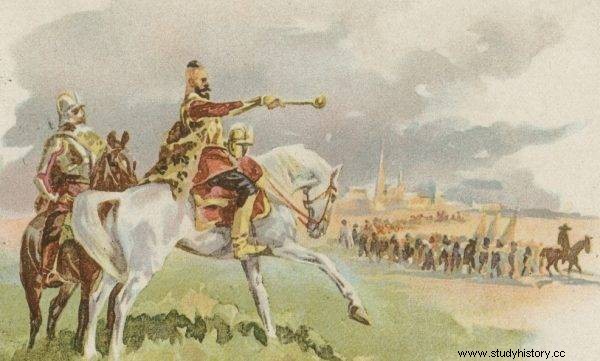
One of the commanders of the Polish army at Beresteczek was Prince Jeremi Wiśniowiecki.
When, however, an old Masovian nobleman killed a more significant Tatar, the fallen's furious compatriots threw themselves at the Polish skirmishers. In response, the regiments of the Crown Standard-Bearer Aleksander Koniecpolski and the Grand Marshal of the Crown Jerzy Lubomirski carried out a counterattack. Later, Prince Jeremi Wiśniowiecki, at the head of six Cossack banners, and Stefan Czarniecki, who led Hetman Potocki's hussar banner, entered the fray; and finally, a common movement of the nobility of Kraków, Sandomierz, Łęczyca and Ruthenia.
The Tatars held the field for an hour and then ran away. The first day of the Battle of Beresteczek was happy for the Poles. They suffered minor losses. "They hardly lost any companion," wrote the memoirist Stanisław Oświęcim. In turn, among the Tatars, there were about 100 killed, and a further 20 were taken prisoner.
It was learned from the prisoners that they clashed with a unit of several thousand, which was more for reconnaissance than for a battle. The real showdown was yet to take place.
Read also:Stefan Czarniecki - national hero, bloody commander and ... greedy hetman
Day two
The army of Chmielnicki - as historians estimate - numbered from 90,000 to 100,000 people, including 40,000 Cossacks. The rest was black, a local peasant whose combat value left much to be desired. The Hetman used every means to stop them. The Crimean Khan, Islam Gerej III, came to the rescue at the head of an army of 25,000–30,000 warriors.
On the second day of the battle, June 29, the enemies began to act. They quickly mastered the crossing of the Plaszówka River on the way to the Polish camp, guarded by a dragoon banner with only a few field cannons. Then the Tartar and Cossack cavalry moved towards the Polish camp.
At that time, the Poles led the way under the command of the Grand Hetman of the Crown, Mikołaj Potocki. First, they clashed with Tatar skirmishers walking in the avant-garde, who were chased away from the hill in front of the camp. The joy of success did not last long, because soon the entire enemy cavalry approached and - the battle started, which Romuald Romański describes as "the greatest cavalry battle of the world at that time".
The battle was extremely chaotic, Potocki definitely did not fulfill his role as commander-in-chief. Everything was done without order and composition, every Polish commander did what he wanted. He fought on his own and, if possible, supported his colleagues.
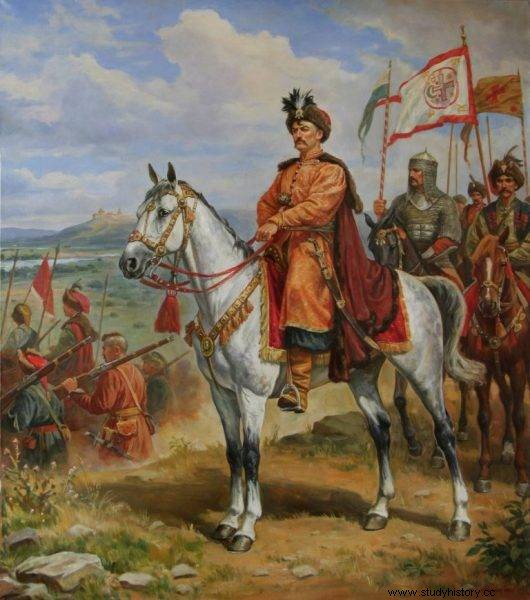
At Berestecki, Chmielnicki brought an army of possibly even 100,000 people.
The enemy first attacked the Polish left wing, commanded by Field Hetman Kalinowski, who had to retreat to the trenches. The Tatars, showering the Poles with a thousand arrows, tried to get to the rear of this grouping, but the charge of Stanisław Potocki, the Podole voivode's regiment, knocked the idea out of their heads. Later, the enemy struck the center, from where it was driven out thanks to the counterattack of prince Jeremy Wiśniowiecki, and finally on the right wing.
Finally in the afternoon the enemy was thrown back and the cavalry returned to the camp. As for the greatest cavalry clash of the era, the number of deaths was not dramatically high - about 300 soldiers on the Polish side, over a thousand on the opposite, including the famous Perekop Bey Tuhai Bey.
However, the mood in the Polish army was far from optimistic. Only the enemy cavalry was faced, and yet the Cossack infantry with the rolling stock was approaching! Hetman Potocki and Kalinowski opted to lock themselves up in the camp. Jan Kazimierz had a different opinion. The king proposed to go on the offensive, take the entire army out of the camp and settle the matter in a general battle.
Read also:Cuttlefish 1666, or the Polish-Polish slaughter
Day three
At dawn on June 30, 1651, the Polish army left the camp. They were arranged - on the advice of general Krzysztof Houwaldt - in a checkerboard pattern, mixing cavalry and infantry units. The right wing was commanded by the Voivode of Bracław, Stanisław Lanckoroński, the left wing - formally Hetman Kalinowski, and in fact Jeremi Wiśniowiecki. In the center was the royal division composed of dragoons, infantry, raiders and arquebusers, reinforced with the banners of hussars.
The morning was misty. Only around 10 o'clock did the armies see each other. More enemy units were approaching the battlefield. The right wing of the enemy troops was occupied by the Cossacks, and the left wing by the Tatars.
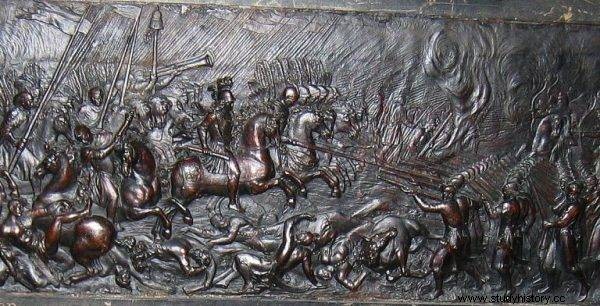
Fragment of a relief from the tombstone of the heart of John II Casimir in the Church of Saint-Germain-des-Prés in Paris depicting the Battle of Beresteczka.
Nobody was eager to start the battle. Minutes passed, hours - until three o'clock came. Some already thought that the fight would not take place. King Jan Kazimierz hesitated. His doubts were dispelled by the arrival of the starost of Bydgoszcz, Zygmunt Denhoff, sent by the prince of Wiśniowiecki, asking for permission to attack. The honest monarch, with his Lord's blessing, made an orderly to stumble.
The trumpets were blew, the drums were banged - and a dozen or so banners led by Prince Jeremy went to the Cossack position.
"Half his ankle is blackened"
Wiśniowiecki rushed at the head, without armor and helmet, but with a saber in his hand. Soon clouds of dust covered the fighters. The Cossacks were assisted by some Tatars led by a nuradin (that is, the third person in the Crimean Khanate, Gazi Gereja, after the Khan and Kalga). Jan Kazimierz immediately launched a few units into battle, which, although surrounded by the vast majority of Tatars, gave Wiśniowiecki's soldiers a moment of respite.
Later, the monarch ordered the units constituting the center of Polish forces to join the fight. "Either I return with you victor from the field, or I die with you!" He screamed and cheered for battle. These were not mere assurances. The king put himself in great danger, because the enemy, perhaps knowing where the monarch was standing, measured two cannons on the raised royal banner from the side of the forest where the Tatars were. They were beaten in the direction of the monarch so that "half of his leg turned black from the ankle." But he was bravely at the post.
Soon afterwards, Aleksander Otwinowski, who sent both to Turkey and the Tatars, drew attention to the Chanese bun and the great banner on the hill. He explained that Islam Gerej himself must be there. The cannon was aimed and fired. The bullet swept the ensign next to the khan, and he himself was "cleared". It was a turning point in the battle. Terrified, Islam Gerej rushed to flee in panic - followed by the Tatar warriors.

Schematic map of the Battle of Beresteczek
Chmielnicki himself chased after the Tatars in a small guard to stop the Khan and turn the tide of the battle. Islam Gerej didn't feel like it. He ordered the chief of the Cossacks bound and took him with him. Meanwhile, only the rolling stock with Cossack infantry and black remains on the battlefield.
"They would probably have been defeated by God in the rolling stock in no time, had it not been for the torrential evening rain [...], which, together with the night of Mars, interrupted the work" - wrote Mikołaj Jemiołowski, one of the participants in the battle.
After the siege, interrupted by negotiations, the Cossack fleet was captured on July 10, 1651. There was no mercy for the Cossacks and peasants who escaped.
"We've wasted Beresteczko ..."
Beresteczko was a great victory. The triumph opened the way for Poles to Ukraine. Lithuanian field hetman Janusz Radziwiłł entered Kiev on August 4. This could be the end of the Cossack rebellion. However, it was not possible to put a dot on the Beretta victory. There were too few professional soldiers to finally crush the enemy. On September 28, a peace was concluded in Biała Cerkiew that did not last even a year.
"We wasted Beresteczko more than Grunwald," complained with complete righteousness the eminent 19th-century historian Stanisław Smolka.
Find out more:
- Kubala L., Historical sketches. First series , published by the Gubrynowicz and Schmidt bookstores, Lviv 1880.
- Nowak T.M., Wimmer J., History of the Polish army 963–1795 , Wiedza Powszechna, Warsaw 1981.
- Podhorodecki L., The Crimean Khanate and its relations with Poland in the 15th-18th centuries , Book and Knowledge, Warsaw 1987.
- Romanski R., Beresteczko 1651 , Bellona, Warsaw 1994.
- Serczyk W.A., In burning Ukraine. The history of Kozaczyzny 1648–1651 , Book and Knowledge, Warsaw 1999.
- Wójcik Z., Wild Fields on fire. On Cossacks in the former Polish-Lithuanian Commonwealth , Wiedza Powszechna, Warsaw 1971.
